Q. What are the goals of space medicine research?
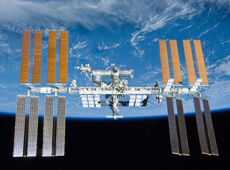
International Space Station (Courtesy: NASA)
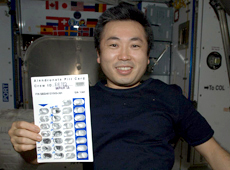
Astronaut Koichi Wakata holding a bisphosphonate agent (Courtesy: NASA/JAXA)
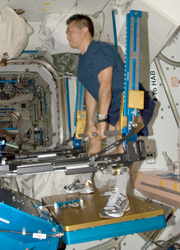 Astronaut Koichi Wakata training his muscles (Courtesy: NASA/JAXA)
Astronaut Koichi Wakata training his muscles (Courtesy: NASA/JAXA)
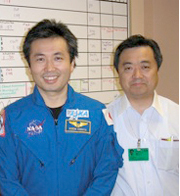
Dr. Hiroshi Ohshima with Astronaut Koichi Wakata, 2 hours after his return from a long-duration space expedition
Traveling to space is humanity’s latest dream. You probably know someone who would seriously consider signing up for a space flight if presented with the opportunity. The inside of the International Space Station (ISS) is maintained at the same atmospheric pressure, temperature, and oxygen level as our environment on Earth; you can live there wearing just a T-shirt and shorts. But other aspects of the environment on the ISS are very different: microgravity, a confined space similar to the inside of a jumbo jet, more risk of exposure to space radiation, and a mistimed 24-hour biological rhythms (because the ISS orbits the Earth every 90 minutes). As a result, there are risks to the human body: loss of bone mass, disruption of the internal body rhythm, etc. In space medicine research, we are trying to develop "the ultimate preventive medicine" to minimize medical risks for astronauts and to maximize their performance. Q. What kind of space medicine experiments have you performed on Kibo so far? Let me speak first about our research on preventing the loss of bone mass. On the ground, there is 1 G of gravity. When we exercise on the ground, 1 G gravity produces the compressive load on the bones and the load causes calcium to accumulate there. In space, there is microgravity. There is no load placed on the bones and calcium is released, reducing bone mass about ten times faster than in a patient with osteoporosis. According to data from NASA, the strength of the femoral neck, which is often involved in hip fractures, is reduced by 2.5 percent a month on average during human space flight-that’s 15 percent in 6 months. So the risk of bone fractures after returning to Earth is greatly increased. To prevent this, astronauts exercise 2 hours a day on the ISS, but studies have shown that traditional exercise alone doesn’t fully prevent the loss of bone mass. We worked with Professor Toshio Matsumoto from the University of Tokushima and found the idea of using a therapeutic agent for osteoporosis to prevent the loss of bone mass. Through 90-day bed rest research on Earth, we confirmed that the therapeutic agent we used has a preventive effect in the loss of bone mass, without any side effects.
Based on these results, JAXA and NASA decided to collaborate on a space biomedical experiment on preventing the loss of bone mass during space flight. Concretely speaking, this research examines whether bisphosphonate used in osteoporosis treatment have a preventive effect on the loss of bone mass during space flight. I’m participating in this research as the JAXA’s co-investigator with Professor Toshio Matsumoto from the University of Tokushima and Professor Toshitaka Nakamura from the University of Occupational and Environmental Health and Professor Kenjiro Khori from Nagoya City University.
The first human subject for this experiment was astronaut Koichi Wakata, who stayed on the ISS for four and a half months in 2009. Astronaut Wakata took bisphosphonate for osteoporosis once a week in space, and the result was positive. Although the actual data are subject to privacy rules, Wakata told the media that the loss of his bone mass was not as much as previously expected.
Before making the research results available to the public, we need to collect data from several subjects, so that people cannot identify each individual private data. Our research is still ongoing, we thanks to the participation of our human subjects-including astronauts Wakata and Noguchi and several from other countries-we are making progress. It seems that astronauts can reduce the loss of bone mass by consuming the appropriate nutrients, such as calcium and vitamin D, incorporating an effective exercise program, and taking minimal amounts of medication.
When Astronaut Wakata returned to Earth from a long-duration space expedition, I was on standby as a rehabilitation doctor at the medical facility in NASA’s Kennedy Space Center. Two hours after his return, I saw him walking rigorously without any help. After a medical examination, he attended a press conference with the other crew members of short space shuttle flight within only 4 hours after returning to Earth. In these first 4 hours, Astronaut Wakata didn’t need any help at all with walking. There have been only a few NASA astronauts who could attend the press conference at Kennedy Space Center right after their return from a long-term stay in space. Wakata paid extra attention to health management during his flight and consistently worked on the in-orbit exercise program we had planned with the aid of NASA’s training expert. I think that is why he was able to walk without help.
Q. What other experiments have been performed?
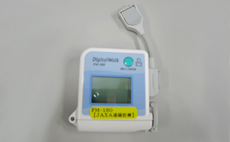
Electrocardiograph (Courtesy: Fukuda Denshi Co., Ltd.)
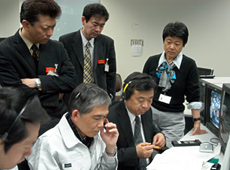
Scientists on the ground watching the data acquisition status in space-telemedicine experiment
With a small-size electrocardiograph and a high-vision camera, we verified a space tele-medicine experiment between Kibo in orbit and the Tsukuba Space Center. Using a Japanese-made, lightweight, and palm-sized electrocardiograph, an astronaut’s electrocardiographic waveforms for 24 hours was recorded and downloaded to Earth.
Our body is controlled by two kinds of autonomic nervous systems: the sympathetic nerve system and the parasympathetic nerve system. The sympathetic system works predominantly during the day, when we are more active, and the parasympathetic system works mainly at night, while we are at rest. Our circadian rhythm is a 24-hour cycle that uses these two nervous systems to help us maintain our body’s internal biological balance. When you obtain 24-hour electrocardiogram data, you can evaluate an irregular heartbeat and autonomic nervous function. If there is an abnormal waveform, showing turbulence in the circadian rhythm due to an irregular autonomic rhythms or circulatory problems, a doctor could say to the patient something like: "You should rest your body a bit because there is turbulence in your circadian rhythm," before the patient develops angina or a decline in conditioning.
We also performed a remote diagnosis of the skin. Astronauts took pictures of the spots where they had attached electrodes for their electrocardiogram, and a doctor on the ground looked at the images to confirm whether these electrodes were placed correctly. Then, when the electrodes were removed, a doctor made a remote diagnosis to see if there was any skin reaction, such as a rash. If there was a skin rash, the doctor would encourage use of an ointment at an early stage. Through this experiment with an electrocardiograph and camera, we were able to verify that we could practice tele-medicine between Kibo and the Tsukuba Space Center. We will continue to experiment with other practical applications and try to expand the variety of technology available for space tele-medicine.
In other JAXA research, we are monitoring the dosage of space radiation the astronauts are exposed to and studying fungi attached to their skin and nasal cavity. These fungi are also known as mold, which cause athlete’s foot. On the ground, fungi are usually found on the feet due to the influence of gravity, but in zero-gravity space fungi can float around, and it is undeniable that they might affect other parts of the human body.
After the space shuttle retires this year, it will be difficult for us to bring back research materials from space to ground. So, JAXA designed an experiment that doesn’t require transportation of heavy objects. We are doing research on astronauts’ hair by sampling before, during, and after the flight and analyzing the accumulated minerals, such as calcium in the stem, as well as the genes and protein expression in the hair root cells. Hair responds sensitively to external factors such as stress, so we will evaluate the stress responses to find out whether monitoring hair can be useful in health monitoring during human space flight.
